The Photography of Dick Swanson
- About Dick Swanson
- The Photographs
- Fine Art Prints Available for Purchase
- The Richard C. "Dick" Swanson Collection at the Bentley Historical Library
About Dick Swanson
Richard C. "Dick" Swanson (1933-2009) was an award-winning American photographer known primarily for the black-and-white photographs he created in Michigan, South Florida, and North Carolina from the 1940s to the 1990s.
Swanson's photographs from the 1940s and 1950s (taken when he was a teenager) were part of the social documentary tradition. During the 1970s and 1980s, he refined and mastered his craft through intensive darkroom experimentation and improvisational "street" photography, creating an extensive portfolio of images.
Swanson's images have appeared in several publications and won awards at many national juried exhibitions. Over 20 U.S. museums and other institutions hold his prints in their collections.
![]() Download Dick Swanson's Biography
Download Dick Swanson's Biography

Dick Swanson, ca. 1984.
The Photographs
Dick Swanson often referred to his portfolio of older and newer works as “Second Generation Photographs” because they reflected two eras in America separated by 30 years in the life of the photographer:
- First Period (1940s–1950s): Large format (4x5) photo journalism/social documentary photos (primarily from Vassar, Michigan)
 View "First Period" Gallery
View "First Period" Gallery
- Second Period (1970s–1980s): SLR (35mm) abstract, darkroom experimentation, "street" and candid photos from various U.S. locales (primarily South Florida, as well as North and South Carolina, Minnesota, Oregon and California).
 View "Second Period" Gallery
View "Second Period" Gallery
The older images are unique documents of post-World War II Michigan civic and daily life (and death), thematically similar to the work of Walker Evans and Weegee and created a decade before Robert Frank published The Americans. Here's a quote from a review of the 1986 exhibition New Developments: Contemporary American Photo Work at the Meisel Gallery in New York:
— Vicki Goldberg, American Photographer, Oct 1986
Swanson's more recent images are excellent representatives of stylistic trends in mid-to-late 20th century art photography, comparable to the work of his contemporaries Elliott Erwitt, Lee Friedlander and Garry Winogrand (with whom Swanson studied).
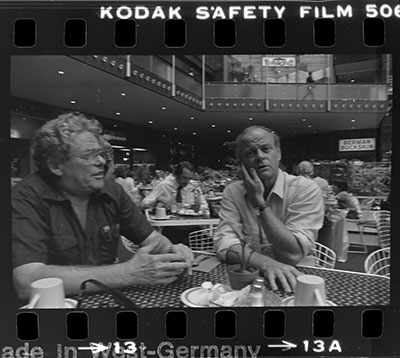
Garry Winogrand and Dick Swanson, St. Paul, Minnesota, 1981.
Fine Art Prints Available for Purchase
We have a limited number of Dick Swanson's original black & white prints available for purchase. These are traditional gelatin silver prints Swanson printed himself in his darkroom in the 1970s–1990s using the original negatives. Gelatin silver prints are noticeably higher in quality than digital prints and have greater value as collectible works of fine art.
To see the available prints and purchase information, go to the top right of this page.
The Richard C. "Dick" Swanson Collection at the Bentley
In 2016 the Bentley Historical Library at the University of Michigan (Ann Arbor) agreed to acquire the Richard C. "Dick" Swanson Collection for its archive.

The Bentley has received (or will receive) Dick Swanson's core collection of hundreds of fine art prints, personal papers, and slides and negatives, as well as full copyright ownership. The archive eventually will be accessible online for research purposes. Note: There will be a "limbo" period during which Swanson Media will continue to handle licensing requests until the Bentley has acquired and processed the full collection and is ready to manage such requests.
Under a license agreement with the University, Swanson Media will continue to publish Dick Swanson's images (website, prints and books).
Updated 26 November 2023
Original Dick Swanson Fine Art Prints
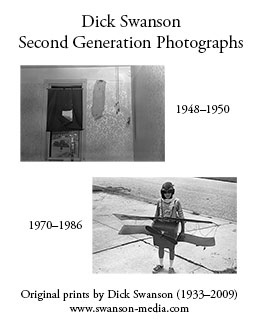
Below are links to the Dick Swanson gelatin silver prints available for purchase. Most prints are unmounted/unmatted. Many are dry mounted on archival-quality mat board, while a few are fully matted. Several are signed and/or stamped/labeled by the photographer.
Prices range from $30 to $400 depending on print/mat size and condition, whether it is mounted/matted, and whether it is signed. Bulk discounts are available if you wish to order multiple prints.
Print/mat condition grades (scale of 1 to 10):
10 (Flawless) — No noticeable imperfections (rare)
9 (Near Flawless) — Very minor flaw that most people would not notice (e.g., tiny spot on border)
8 (Excellent) — Minor flaw(s) visible only under close inspection (e.g., minor handling impressions or edge rippling on an unmounted print)
7 (Very Good) — Obvious minor flaws (e.g., more noticeable handling marks, rippling, dimpling, small spots or border creases)
6 (Good) — More prevalent flaws but they still don't detract too much from the image (e.g., extensive rippling or dimpling; small creases or several minor spots or stains)
5 (Fair) — Significantly flawed, worn or damaged (e.g., crease(s) through the image; more noticeable spots or stains)
4 or lower (Poor) — Severely flawed, worn or damaged (e.g., heavy creases; torn corners; large stains)
The average print condition is "8 (Excellent)" but be aware that many of these prints are over 30 years old. Many were displayed in exhibitions around the country; the prints/mats will show varying signs of handling and may have exhibition labels on the reverse. Many of the flaws on unmounted prints, such as handling impressions, rippling, or dimpling, could be mostly eliminated by having the prints professionally mounted and matted.
Click the thumbnail images below to see large views of the available prints, image/historical details, condition descriptions, and prices.
If you have any questions about the prints, ordering, bulk discounts, shipping, etc., contact Mark Swanson
Prints from the First Period (1940s-1950s)
 Football Player |
 Four Generations |
 High School Cooks |
||
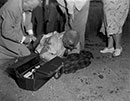 Man Injured in Car Crash [#2] |
 Memorial Park Dedication |
 New Flag |
||
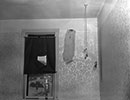 Old Hotel Room |
 People from Estonia |
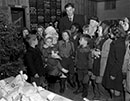 Santa and Kids |
||
 Town Meeting |
 Upside-Down Truck |














